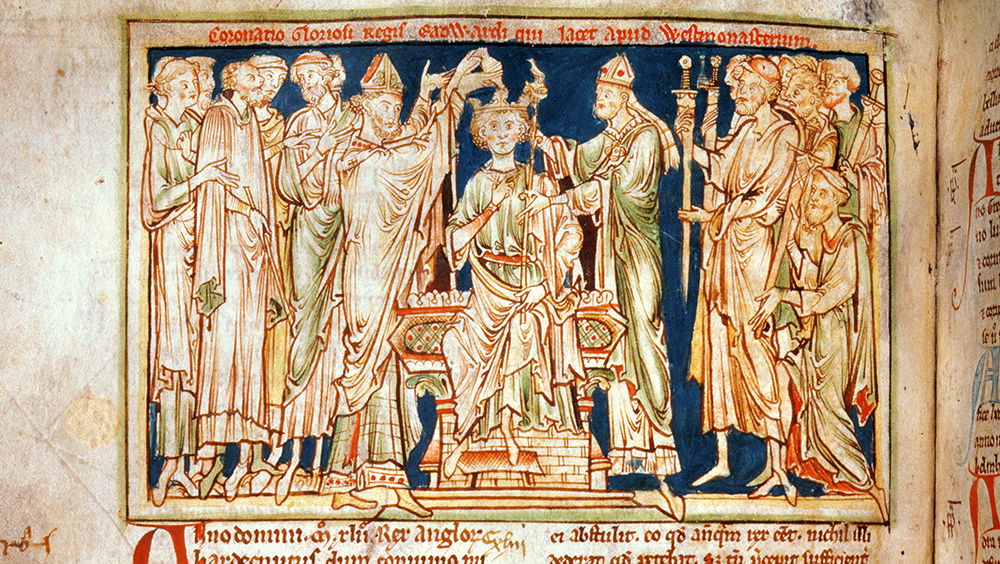Old Traditions and New Hopes - 4 minutes read

It is not often that publications in the field of medieval liturgy can be considered timely, but a new edition from the Henry Bradshaw Society, English Coronation Ordines in the Ninth and Early Tenth Centuries, certainly is. The book, edited by David Pratt, collects the earliest surviving rites for the coronations of Anglo-Saxon kings. In a year when Britain will witness a coronation for the first time in decades, it makes interesting reading. As Rosalind Love says in her preface, the words of this May’s coronation ‘show only a distant echo of those early rites, but … the shape of the ceremony overall can only be understood properly in the light of the ancient orders’.
Some aspects of these ceremonies certainly look very different from what we will see in May: in the earliest rites, the king wore a helmet rather than a crown. But Anglo-Saxon kings, too, were presented with a sword and ring, and promised to maintain law and justice in their kingdom. In the tenth century, that kingdom was still evolving; in the rituals it is sometimes called ‘Albion’, sometimes the land of ‘the Saxons, Mercians and Northumbrians’.
The prayers and blessings are rich with biblical allusions, some of which survive into the modern ceremony. As the king was anointed, ‘Zadok the priest and Nathan the prophet anointed Solomon king’ was sung (admittedly, in Latin and to a less rousing setting than Handel’s). At the end of the ceremony, the congregation cried ‘Vivat rex’, and all came to kiss the king.
This liturgy, or something like it, was used at a significant Anglo-Saxon coronation exactly 1,050 years ago. On 11 May 973, King Edgar was crowned in Bath, in a ceremony which made a deep impression on contemporaries. The event was so significant that it is commemorated in the Anglo-Saxon Chronicle, unusually, with a poem. It begins: ‘Here Edgar, ruler of the English, was hallowed as king, among a great crowd in the ancient city, Acemannesceastre, the same which the island-dwellers also call by another name, Bath. There was much bliss for everyone on that blessed day … There were gathered a host of priests, a large throng of monks, I have heard, and of the wise.’
The historian-poet who recorded this event had an ambitious sense of scale, placing this ‘blessed day’ into a larger context of time and history. He sets Edgar and his island-dwellers in line with Roman forebears, invoking the Roman name for Bath by calling it Acemannesceastre (probably descended from Aquae Sulis). With its monumental Roman ruins, Bath was a resonant choice of site, imbued with memories of ancient imperial power.
Reckoning up the date, the poet goes even further back: ‘At that time had passed ten hundred winters in the count of reckoning from the birth of the glorious King, Guardian of Lights, except there were left a tally of winters, seven and twenty’. This is a riddling way of saying it was 973 (1,000 minus 27), a year whose proximity to the millennium seemed to this poet meaningful. Perhaps he would get equally excited about 2023, two decades in the other direction from another millennial year, another thousand winters further on in time.
The poet delights in zooming in and out on the event, balancing the vast and the specific – 1,000 years of time, and one particular day in one English city. The history of liturgy encourages thinking about time on a big scale, because it deals with rituals which are both stable and constantly changing. Liturgy provides a script of words and gestures full of meaning, which may be repeated over many generations, hallowed by history.
However, the script is always being tweaked and adapted, and it only comes alive in the moment of performance. Even if the words stay the same, the people who say and hear them are different, so the particular context of any ritual creates different meanings every time. Such ceremonies offer an intersection between the timeless and the immediate, history and the present moment.
A ritual more than 1,000 years old has naturally changed its meaning considerably over time, and in some ways the world of the Anglo-Saxon coronation rites feels immensely distant from our own. But when reading these liturgies the strongest echoes are not the details of the ritual but the hopes expressed – the desire for a land of peace and justice, for good government and seasons of prosperity. Whatever form they take, those wishes really are timeless.
Eleanor Parker is Lecturer in Medieval English Literature at Brasenose College, Oxford and the author of Conquered: The Last Children of Anglo-Saxon England (Bloomsbury, 2022).
Source: History Today Feed